Refined Beet Market
Refined Beet Market Size and Share Forecast Outlook 2025 to 2035
Refined Beet Market is projected to grow from USD 52.0 billion in 2025 to USD 69.2 billion by 2035, at a CAGR of 2.9%. Europe will dominate with a 78.0% market share, while refined white will lead the grade segment with a 88.0% share.
Refined Beet Market Forecast and Outlook 2025 to 2035
The global Refined Beet Market is valued at USD 52.0 billion in 2025 and is slated to reach USD 69.0 billion by 2035, recording an absolute increase of USD 17.0 billion over the forecast period. This translates into a total growth of 32.7%, with the market forecast to expand at a CAGR of 2.9% between 2025 and 2035. The overall market size is expected to grow by nearly 1.3 times during the same period, supported by increasing global food production demand, growing confectionery industry expansion, and rising adoption of natural sweetening solutions across diverse food manufacturing and beverage production applications.
Quick Stats for Refined Beet Market
- Refined Beet Market Value (2025): USD 52.0 billion
- Refined Beet Market Forecast Value (2035): USD 69.0 billion
- Refined Beet Market Forecast CAGR: 2.9%
- Leading Production Region in Refined Beet Market: Europe (78.0%)
- Key Growth Regions in Refined Beet Market: Europe, North America, and Asia Pacific
- Key Players in Refined Beet Market: Südzucker, Nordzucker, Tereos, Cristal Union, British Sugar (ABF), Pfeifer & Langen
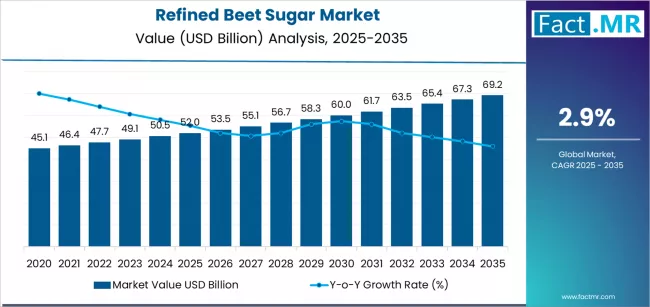
Between 2025 and 2030, the market is projected to expand from USD 52.0 billion to USD 59.8 billion, resulting in a value increase of USD 7.8 billion, which represents 45.9% of the total forecast growth for the decade. This phase of development will be shaped by increasing food industry demand recovery, rising confectionery production expansion, and growing adoption of refined sugar solutions in food manufacturing operations. Sugar producers are expanding their production capabilities to address the growing demand for consistent sweetening solutions and enhanced processing reliability.
Refined Beet Market Key Takeaways
| Metric | Value |
|---|---|
| Estimated Value in (2025E) | USD 52.0 billion |
| Forecast Value in (2035F) | USD 69.0 billion |
| Forecast CAGR (2025 to 2035) | 2.9% |
From 2030 to 2035, the market is forecast to grow from USD 59.8 billion to USD 69.0 billion, adding another USD 9.2 billion, which constitutes 54.1% of the overall ten-year expansion. This period is expected to be characterized by the expansion of organic and specialty sugar systems, the integration of advanced processing technologies, and the development of enhanced purification methods for major food manufacturers. The growing adoption of quality enhancement programs and efficient production initiatives will drive demand for refined beet sugar with enhanced purity standards and improved manufacturing efficiency.
Between 2020 and 2025, the market experienced steady recovery growth, driven by increasing food production demand recovery and growing recognition of beet sugar as essential ingredient for confectionery manufacturing and beverage production. The market developed as food manufacturers and beverage companies recognized the potential for refined products to enhance sweetening quality while maintaining cost effectiveness and improving production reliability. Technological advancement in sugar processing and purification systems began focusing the critical importance of maintaining product purity and operational efficiency in food manufacturing operations.
Why is the Refined Beet Market Growing?
Market expansion is being supported by the increasing global food production volumes and the corresponding need for reliable sweetening ingredients that can maintain product quality and taste consistency while supporting diverse food manufacturing applications across various industry environments. Modern food manufacturers and beverage producers are increasingly focused on implementing sweetening solutions that can reduce production costs, minimize quality variations, and provide consistent performance in food processing operations. Refined beet sugar's proven ability to deliver enhanced sweetening efficiency, reliable processing capabilities, and versatile food production applications make them essential ingredients for contemporary food manufacturing operations and beverage production solutions.
The growing focus on food industry modernization and production efficiency is driving demand for refined beet sugar that can support large-scale manufacturing, reduce processing complexities, and enable efficient production operations across varying food processing configurations. Manufacturer preference for ingredients that combine purity with cost-effectiveness and processing reliability is creating opportunities for innovative production implementations. The rising influence of quality standards and food safety regulations is also contributing to increased adoption of refined beet sugar that can provide advanced purity control without compromising performance or regulatory compliance.
Opportunity Pathways - Refined Beet Market
The Refined Beet Market is poised for robust growth and transformation. As food manufacturers and beverage producers across both developed and emerging markets seek sweetening ingredients that are pure, cost-effective, reliable, and compliant, refined beet sugar systems are gaining prominence not just as sweetening ingredients but as strategic components for production efficiency, quality consistency, cost optimization, and regulatory compliance.
Rising food production and industry modernization in Europe, North America, and Asia Pacific amplify demand, while producers are picking up on innovations in processing technologies and quality enhancement methods.
Pathways like organic production, specialty grades, and advanced processing promise strong margin uplift, especially in developed markets. Geographic expansion and application diversification will capture volume, particularly where food production is growing or manufacturing infrastructure requires modernization. Quality pressures around purity standards, processing efficiency, cost optimization, and regulatory compliance give structural support.
- Pathway A - Organic & Specialty Sugar Solutions. Food manufacturers increasingly require ingredients that meet organic standards and specialty applications. Sugar producers who specialize in organic production or enhance specialty capabilities can command a premium. Expected revenue pool: USD 3.5-4.2 billion
- Pathway B - Advanced Processing & Purification. Enhanced processing systems -- improved crystallization, advanced purification, quality optimization -- improve product purity and manufacturing efficiency. Opportunity: USD 2.8-3.4 billion
- Pathway C - Food Industry Integration. Direct partnerships with food manufacturers, customized specifications, and technical support optimize supply chain efficiency and enhance customer relationships. Systems with stronger integration capabilities will allow premium positioning. Revenue lift: USD 2.2-2.8 billion
- Pathway D - Specialized Application Development. Extending reach into pharmaceutical applications, industrial uses, and specialty food markets. Industries will look for sugar suppliers who provide reliable, pure sweetening solutions. Pool: USD 2.0-2.6 billion
- Pathway E - Emerging Market Expansion. Strong growth in developing food markets, urbanization trends, and food industry development. Local partnerships and processing facilities help penetration. Expected upside: USD 1.8-2.2 billion
- Pathway F - Quality Enhancement Services. Testing services, technical support, and quality assurance help manufacturers ensure product specifications and regulatory compliance. Service approaches benefit from long-term relationships. USD 1.2-1.6 billion
- Pathway G - Efficient Production Solutions. Energy efficiency, waste reduction, and production optimization create cost advantages and environmental compliance benefits. Pool: USD 1.0-1.4 billion
Segmental Analysis
The market is segmented by region (production), grade, and end use. By region (production), the market is divided into Europe, North America, and Others. By grade, it covers refined white and brown/specialty. By end use, it is segmented into food & beverage, industrial, and others. Regionally, the market is divided into North America, Europe, Asia Pacific, Latin America, and Middle East & Africa.
By Region (Production), the Europe Segment Accounts for 78.0% Market Share
.webp)
The Europe production region is projected to account for 78.0% of the market in 2025, reaffirming its position as the leading production category. European sugar producers increasingly utilize beet sugar production for their proven agricultural compatibility, established processing infrastructure, and cost-effectiveness in sugar manufacturing across food industry supply, confectionery production, and beverage manufacturing applications. European beet sugar technology's established cultivation procedures and consistent quality output directly address the food industry requirements for reliable sweetening supply and production efficiency in diverse manufacturing environments.
This regional segment forms the foundation of current global sugar operations, as it represents the region with the greatest production capacity and established agricultural infrastructure across multiple applications and manufacturing scenarios. Producer investments in enhanced cultivation methods and processing optimization continue to strengthen adoption among European sugar companies. With producers prioritizing production reliability and supply consistency, European operations align with both quality objectives and cost management requirements, making them the central component of comprehensive sugar supply strategies.
By Grade, the Refined White Segment Accounts for 88.0% Market Share
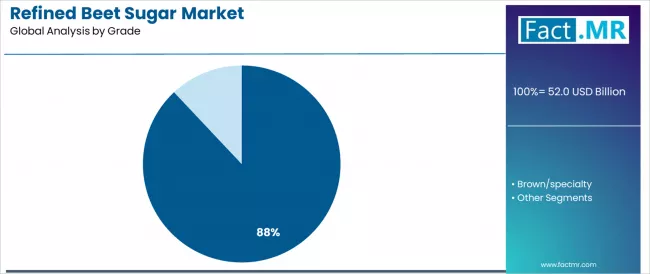
Refined white grade is projected to represent 88.0% of refined beet sugar demand in 2025, highlighting its critical role as the primary grade requirement for food manufacturers and beverage producers. Food manufacturers prefer refined white beet sugar for their purity standards, established processing compatibility, and ability to provide consistent sweetening while supporting product quality and consumer acceptance requirements. Positioned as standard ingredient for modern food production, refined white sugar offers both processing advantages and quality benefits.
The segment is supported by continuous innovation in refining processes and the growing availability of specialized purification methods that enable enhanced purity with improved processing capabilities. Food manufacturers are investing in quality optimization to support large-scale production and consumer satisfaction delivery. As food quality becomes more prevalent and purity requirements increase, refined white grade will continue to dominate the grade market while supporting advanced food processing and manufacturing quality strategies.
By End Use, the Food & Beverage Segment Accounts for 86.0% Market Share
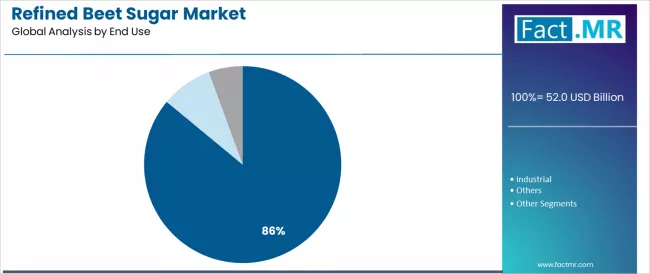
Food & beverage applications are projected to represent 86.0% of refined beet sugar consumption in 2025, highlighting their critical role as the primary end use for sweetening applications and product manufacturing. Food & beverage manufacturers prefer refined beet sugar for their versatile applications, reliable sweetening performance, and consistent quality in production processes while supporting taste requirements and consumer preferences. Positioned as essential ingredient for modern food production, food & beverage applications offer both functional advantages and market benefits.
The segment is supported by continuous innovation in food manufacturing and the growing availability of specialized sugar grades that enable diverse applications with enhanced processing performance. Manufacturers are investing in recipe optimization to support product development and market expansion. As food production becomes more prevalent and application requirements increase, food & beverage end use will continue to dominate the application market while supporting advanced manufacturing processes and consumer satisfaction strategies.
What are the Drivers, Restraints, and Key Trends of the Refined Beet Market?
The Refined Beet Market is advancing steadily due to increasing food production volumes and growing adoption of quality sweetening infrastructure that provides enhanced processing efficiency and taste consistency across diverse food manufacturing applications. The market faces challenges, including agricultural yield variations, processing equipment costs, and varying quality requirements across different industry environments. Innovation in cultivation techniques and processing technologies continues to influence product development and market expansion patterns.
Rising Global Food Production and Industry Modernization
The growing expansion of food manufacturing and industry infrastructure development is enabling sugar producers to develop refined beet sugar systems that provide superior sweetening quality, enhanced processing compatibility, and reliable performance in large-scale manufacturing environments. Advanced processing systems provide improved production capacity while allowing more effective sweetening delivery and consistent quality performance across various applications and manufacturing requirements. Producers are increasingly recognizing the competitive advantages of modern processing capabilities for production efficiency and food industry positioning.
Processing Innovation and Quality Enhancement Drive Sugar Development
Modern refined beet sugar producers are incorporating advanced purification methods and quality control systems to enhance product purity, improve processing efficiency, and ensure consistent performance delivery to food manufacturers. These technologies improve quality standards while enabling new applications, including specialty grades and customized specifications. Advanced processing integration also allows producers to support premium product positioning and quality optimization beyond traditional sugar ingredient supply.
Analysis of the Refined Beet Market by Key Countries
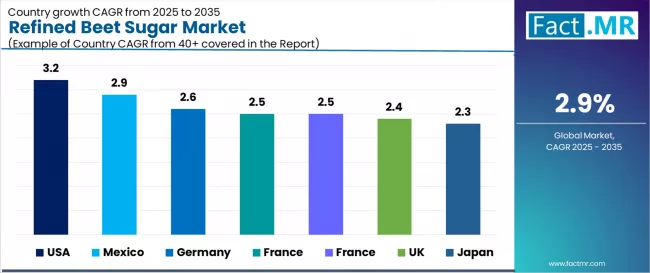
| Country | CAGR (2025-2035) |
|---|---|
| USA | 3.2% |
| Mexico | 2.9% |
| Germany | 2.6% |
| France | 2.5% |
| South Korea | 2.5% |
| United Kingdom | 2.4% |
| Japan | 2.3% |
The market is experiencing steady growth globally, with the USA leading at a 3.2% CAGR through 2035, driven by extensive food industry expansion, advanced processing infrastructure investments, and significant adoption of efficient production technologies. Mexico follows at 2.9%, supported by growing food manufacturing development, rapid agricultural modernization, and growing adoption of advanced processing systems. Germany shows growth at 2.6%, focusing quality standards and advanced production capabilities. France and South Korea record 2.5%, focusing on industry modernization and production optimization. The United Kingdom demonstrates 2.4% growth, supported by food industry requirements and processing modernization. Japan demonstrates 2.3% growth, supported by quality enhancement but constrained by market maturity.
The report covers an in-depth analysis of 40+ countries, top-performing countries are highlighted below.
United States Demonstrates Food Industry Innovation
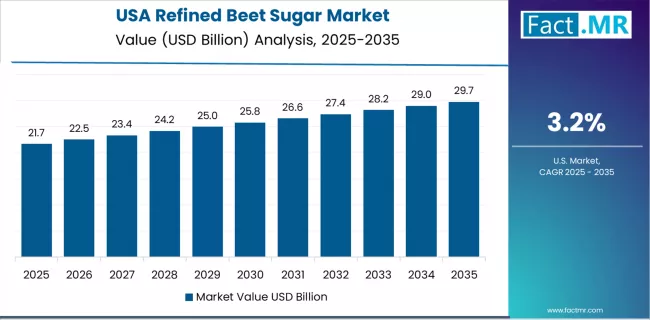
The U.S. market emphasizes advanced processing features, including precision quality control and integration with comprehensive food manufacturing platforms that manage production efficiency, cost optimization, and quality assurance applications through unified processing systems. The country demonstrates strong growth at 3.2% CAGR, driven by food industry modernization, beverage production expansion, and emerging organic food applications that support processing system integration. American food manufacturers prioritize operational effectiveness with refined beet sugar delivering consistent sweetening performance through advanced processing algorithms and manufacturing adaptation capabilities.
Technology deployment channels include major food processors, specialized agricultural suppliers, and beverage industry procurement programs that support professional applications for complex food manufacturing and beverage production applications. Manufacturing platform integration capabilities with established food systems expand market appeal across diverse operational requirements seeking precision and reliability benefits. The resilient food sector and expanding processing capacity additions create steady demand, while innovative applications in organic food production open new growth avenues.
Performance Metrics:
- Food processing facilities in California, Minnesota, and Michigan leading sugar adoption for commercial food production operations
- Agricultural contractor channels maintaining 72% market share for complex food manufacturing integration applications
- Commercial beverage programs supporting 31% of sugar acquisitions across food and beverage facilities
- Manufacturing platform compatibility with major food systems driving procurement selection criteria
Mexico Maintains Agricultural Leadership
Mexico's expanding agricultural market demonstrates sophisticated refined beet sugar deployment with documented operational effectiveness in food manufacturing applications and beverage production facilities through integration with existing processing systems and agricultural infrastructure. The country leverages agricultural expertise in sugar production and food systems integration to maintain strong growth at 2.9% CAGR. Agricultural centers, including Jalisco, Veracruz, and Sinaloa, showcase premium installations where processing systems integrate with comprehensive food platforms and agricultural management systems to optimize production and processing effectiveness.
Mexican agricultural companies prioritize system reliability and regional compliance in sugar development, creating demand for premium processing systems with advanced features, including production monitoring integration and automated cultivation systems. The market benefits from established agricultural infrastructure and a willingness to invest in advanced processing technologies that provide long-term operational benefits and compliance with international food and agricultural standards. Premium food applications, beverage production systems, and export programs drive diversified demand across multiple end-use segments.
Market Intelligence Brief:
- Agricultural focuses on regional standardization and food industry compliance, driving premium segment growth
- Agricultural partnerships providing 42% faster development cycles
- Technology collaboration between Mexican agricultural producers and international food companies
- Processing training programs expanding sugar system integration in food and beverage scenarios
Germany Emphasizes Processing Excellence
Germany demonstrates steady market development with a 2.6% CAGR, distinguished by food manufacturers' preference for high-quality refined beet sugar systems that integrate seamlessly with existing production systems and provide reliable long-term operation in specialized food applications. The market prioritizes advanced features, including precision quality control, processing durability, and integration with comprehensive manufacturing platforms that reflect German industry expectations for technological sophistication and operational excellence.
Growth drivers encompass food manufacturing optimization applications, expanding confectionery production requirements, and advanced processing system integration. German manufacturers emphasize quality control systems and comprehensive technical support that align with domestic industrial standards. The convergence of advanced food technology, processing industry presence, and traditional agricultural heritage creates diversified demand across multiple application segments.
Market Characteristics:
- Premium focus on refined white systems with advanced processing algorithms and precision quality capabilities
- Integration requirements with existing food manufacturing and beverage production platforms
- Focus on operational reliability and long-term durability in food applications
France Shows Traditional Agricultural Strength
France demonstrates steady expansion at 2.5% CAGR through diversified demand from food programs, confectionery production activities, and beverage manufacturing projects. Major food hubs in regions throughout the country drive sugar adoption for commercial and specialty food production. Agricultural heritage and processing programs create constant food demand, while export and premium applications provide additional growth opportunities. Government support for agricultural modernization and food industry investment supports consistent market development.
Market Characteristics:
- Strong agricultural heritage and established sugar beet cultivation supporting consistent production volumes
- Advanced confectionery and food manufacturing sectors driving demand for premium refined sugar grades
- Export capabilities and international market presence supporting diversified revenue streams
South Korea Emphasizes Food Industry Integration
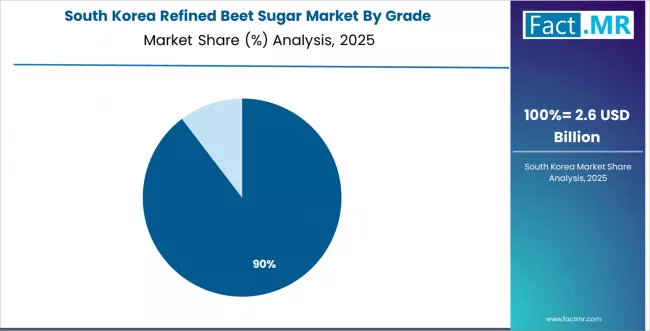
South Korea maintains steady development at 2.5% CAGR through food manufacturing expansion, beverage production growth, and industrial processing applications. Korean food facilities and processing companies are implementing advanced sugar systems to enhance production capabilities and support manufacturing operations that align with quality regulations and efficiency standards. Market expansion benefits from government food programs that mandate ingredient performance capabilities in food and beverage specifications, creating steady demand where operational flexibility and quality compliance represent critical requirements.
Strategic Market Indicators:
- Food manufacturing and beverage production facilities leading adoption with processing modernization programs requiring advanced sugar systems
- Government food programs providing regulatory support for advanced ingredient system acquisition
- Quality compliance requirements driving demand for standardized systems with international operational compatibility
- Specialized confectionery and processed food segments adopting comprehensive sugar solutions for production optimization
United Kingdom Demonstrates Processing Innovation
The U.K. market maintains steady growth at 2.4% CAGR, driven by food industry modernization, beverage production activities, and specialty food applications. British food facilities and agricultural companies are implementing advanced processing systems to enhance agricultural capabilities and support production operations that align with environmental regulations and quality standards. Market expansion benefits from industry procurement programs that mandate processing performance capabilities in food and agricultural specifications, creating constant demand where operational flexibility and environmental compliance represent critical requirements.
Strategic Market Indicators:
- Food processing and agricultural facilities leading adoption with equipment modernization programs requiring advanced processing systems
- Industry procurement providing regulatory support for advanced processing system acquisition
- Environmental compliance requirements driving demand for efficient systems with sustainable operational compatibility
- Specialized confectionery and premium food segments adopting comprehensive processing solutions for production optimization
Japan Shows Quality-Focused Development
.webp)
Japan maintains steady expansion at 2.3% CAGR, distinguished by food manufacturers' preference for high-quality refined beet sugar systems that integrate seamlessly with existing production systems and provide reliable long-term operation in specialized food applications. The market prioritizes advanced features, including precision quality control, processing durability, and integration with comprehensive manufacturing platforms that reflect Japanese industry expectations for technological sophistication and operational excellence.
High-specification food and confectionery applications drive demand, supported by advanced processing research and development initiatives. Japanese manufacturers emphasize ingredient purity, consistent performance characteristics, and comprehensive quality documentation that aligns with stringent industrial standards. The focus on premium applications and technical excellence supports stable growth despite mature market conditions.
Market Characteristics:
- Premium focus on refined white systems with advanced processing algorithms and precision quality capabilities
- Integration requirements with existing food manufacturing and confectionery production platforms
- Focus on operational reliability and long-term durability in food applications
Europe Market Split by Countries
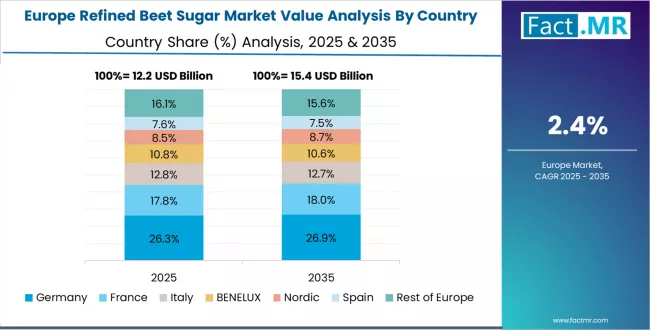
The refined beet sugar market in Europe is projected to grow from USD 25.8 billion in 2025 to USD 33.2 billion by 2035, registering a CAGR of 2.6% over the forecast period. Germany is expected to maintain its leadership position with a 32.4% market share in 2025, increasing to 33.1% by 2035, supported by its advanced sugar processing infrastructure, comprehensive agricultural capabilities, and major production facilities serving European and international markets.
France follows with a 24.6% share in 2025, projected to ease to 24.1% by 2035, driven by established sugar industry heritage, agricultural production programs, and traditional manufacturing capabilities, but facing challenges from competitive pressures and agricultural constraints. United Kingdom holds a 16.8% share in 2025, expected to decline to 16.4% by 2035, supported by food industry requirements and processing modernization but facing challenges from agricultural limitations and market competition. Netherlands commands a 12.2% share in 2025, projected to reach 12.4% by 2035, while Belgium accounts for 8.7% in 2025, expected to reach 8.9% by 2035. The Rest of Europe region, including Nordic countries, Eastern European markets, Poland, Czech Republic, and other European countries, is anticipated to gain momentum, expanding its collective share from 5.3% to 5.1% by 2035, attributed to increasing agricultural development across Eastern European countries and growing food industry modernization across various European markets implementing production efficiency programs.
Competitive Landscape of the Refined Beet Market
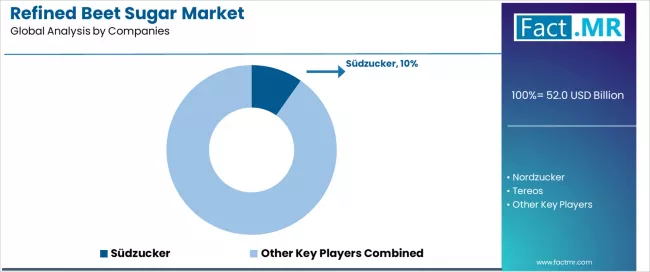
The market is characterized by competition among established sugar producers, specialized agricultural companies, and integrated food ingredient manufacturers. Companies are investing in advanced processing research, agricultural technology development, quality optimization, and comprehensive production portfolios to deliver pure, reliable, and cost-effective refined beet sugar solutions. Innovation in cultivation methods, processing technologies, and quality control capabilities is central to strengthening market position and competitive advantage.
Südzucker leads the market with a 9.8% market share, offering specialized sugar production with a focus on quality standards and efficient processing design for food industry operations. Nordzucker provides comprehensive sugar production portfolios with an focus on agricultural integration, processing innovation, and European market services. Tereos delivers diverse sugar products with a focus on cost-effective production and international market capabilities. Cristal Union specializes in cooperative-based production with focus on farmer integration and quality optimization. British Sugar (ABF) focuses on integrated food ingredients with regional market leadership and advanced processing capabilities. Pfeifer & Langen offers specialized sugar solutions with European operations and quality management systems. Agrana provides sugar products with focus on Central European market leadership and diversified production.
Key Players in the Refined Beet Market
- Südzucker
- Nordzucker
- Tereos
- Cristal Union
- British Sugar (ABF)
- Pfeifer & Langen
- Agrana
- Michigan Sugar
- Amalgamated Sugar
- Cosun Beet
Scope of the Report
| Items | Values |
|---|---|
| Quantitative Units (2025) | USD 52.0 billion |
| Region (Production) | Europe, North America, Others |
| Grade | Refined white, Brown/specialty |
| End Use | Food & beverage, Industrial, Others |
| Regions Covered | North America, Europe, Asia Pacific, Latin America, Middle East & Africa |
| Countries Covered | United States, Canada, Germany, United Kingdom, France, China, Japan, Brazil, India and 40+ countries |
| Key Companies Profiled | Südzucker, Nordzucker, Tereos, Cristal Union, British Sugar (ABF), Pfeifer & Langen, and Agrana |
| Additional Attributes | Production sales by region and grade category, regional demand trends, competitive landscape, technological advancements in processing systems, agricultural development, quality innovation, and production efficiency optimization |
Refined Beet Market by Segments
-
Region (Production):
- Europe
- North America
- Others
-
Grade:
- Refined white
- Brown/specialty
-
End Use:
- Food & beverage
- Industrial
- Others
-
Region:
-
North America
- United States
- Canada
- Mexico
-
Europe
- Germany
- United Kingdom
- France
- Italy
- Spain
- Nordic
- BENELUX
- Rest of Europe
-
Asia Pacific
- China
- Japan
- India
- South Korea
- ASEAN
- Australia & New Zealand
- Rest of Asia Pacific
-
Latin America
- Brazil
- Chile
- Rest of Latin America
-
Middle East & Africa
- Kingdom of Saudi Arabia
- Other GCC Countries
- Turkey
- South Africa
- Other African Union
- Rest of Middle East & Africa
-
Table of Content
- Executive Summary
- Global Market Outlook
- Demand to side Trends
- Supply to side Trends
- Technology Roadmap Analysis
- Analysis and Recommendations
- Market Overview
- Market Coverage / Taxonomy
- Market Definition / Scope / Limitations
- Market Background
- Market Dynamics
- Drivers
- Restraints
- Opportunity
- Trends
- Scenario Forecast
- Demand in Optimistic Scenario
- Demand in Likely Scenario
- Demand in Conservative Scenario
- Opportunity Map Analysis
- Product Life Cycle Analysis
- Supply Chain Analysis
- Investment Feasibility Matrix
- Value Chain Analysis
- PESTLE and Porter’s Analysis
- Regulatory Landscape
- Regional Parent Market Outlook
- Production and Consumption Statistics
- Import and Export Statistics
- Market Dynamics
- Global Market Analysis 2020 to 2024 and Forecast, 2025 to 2035
- Historical Market Size Value (USD Million) Analysis, 2020 to 2024
- Current and Future Market Size Value (USD Million) Projections, 2025 to 2035
- Y to o to Y Growth Trend Analysis
- Absolute $ Opportunity Analysis
- Global Market Pricing Analysis 2020 to 2024 and Forecast 2025 to 2035
- Global Market Analysis 2020 to 2024 and Forecast 2025 to 2035, By Region (Production)
- Introduction / Key Findings
- Historical Market Size Value (USD Million) Analysis By Region (Production) , 2020 to 2024
- Current and Future Market Size Value (USD Million) Analysis and Forecast By Region (Production) , 2025 to 2035
- Europe
- North America
- Others
- Y to o to Y Growth Trend Analysis By Region (Production) , 2020 to 2024
- Absolute $ Opportunity Analysis By Region (Production) , 2025 to 2035
- Global Market Analysis 2020 to 2024 and Forecast 2025 to 2035, By Grade
- Introduction / Key Findings
- Historical Market Size Value (USD Million) Analysis By Grade, 2020 to 2024
- Current and Future Market Size Value (USD Million) Analysis and Forecast By Grade, 2025 to 2035
- Refined white
- Brown/specialty
- Y to o to Y Growth Trend Analysis By Grade, 2020 to 2024
- Absolute $ Opportunity Analysis By Grade, 2025 to 2035
- Global Market Analysis 2020 to 2024 and Forecast 2025 to 2035, By End Use
- Introduction / Key Findings
- Historical Market Size Value (USD Million) Analysis By End Use, 2020 to 2024
- Current and Future Market Size Value (USD Million) Analysis and Forecast By End Use, 2025 to 2035
- Food & beverage
- Industrial
- Others
- Y to o to Y Growth Trend Analysis By End Use, 2020 to 2024
- Absolute $ Opportunity Analysis By End Use, 2025 to 2035
- Global Market Analysis 2020 to 2024 and Forecast 2025 to 2035, By Region
- Introduction
- Historical Market Size Value (USD Million) Analysis By Region, 2020 to 2024
- Current Market Size Value (USD Million) Analysis and Forecast By Region, 2025 to 2035
- North America
- Latin America
- Western Europe
- Eastern Europe
- East Asia
- South Asia and Pacific
- Middle East & Africa
- Market Attractiveness Analysis By Region
- North America Market Analysis 2020 to 2024 and Forecast 2025 to 2035, By Country
- Historical Market Size Value (USD Million) Trend Analysis By Market Taxonomy, 2020 to 2024
- Market Size Value (USD Million) Forecast By Market Taxonomy, 2025 to 2035
- By Country
- USA
- Canada
- Mexico
- By Region (Production)
- By Grade
- By End Use
- By Country
- Market Attractiveness Analysis
- By Country
- By Region (Production)
- By Grade
- By End Use
- Key Takeaways
- Latin America Market Analysis 2020 to 2024 and Forecast 2025 to 2035, By Country
- Historical Market Size Value (USD Million) Trend Analysis By Market Taxonomy, 2020 to 2024
- Market Size Value (USD Million) Forecast By Market Taxonomy, 2025 to 2035
- By Country
- Brazil
- Chile
- Rest of Latin America
- By Region (Production)
- By Grade
- By End Use
- By Country
- Market Attractiveness Analysis
- By Country
- By Region (Production)
- By Grade
- By End Use
- Key Takeaways
- Western Europe Market Analysis 2020 to 2024 and Forecast 2025 to 2035, By Country
- Historical Market Size Value (USD Million) Trend Analysis By Market Taxonomy, 2020 to 2024
- Market Size Value (USD Million) Forecast By Market Taxonomy, 2025 to 2035
- By Country
- Germany
- UK
- Italy
- Spain
- France
- Nordic
- BENELUX
- Rest of Western Europe
- By Region (Production)
- By Grade
- By End Use
- By Country
- Market Attractiveness Analysis
- By Country
- By Region (Production)
- By Grade
- By End Use
- Key Takeaways
- Eastern Europe Market Analysis 2020 to 2024 and Forecast 2025 to 2035, By Country
- Historical Market Size Value (USD Million) Trend Analysis By Market Taxonomy, 2020 to 2024
- Market Size Value (USD Million) Forecast By Market Taxonomy, 2025 to 2035
- By Country
- Russia
- Poland
- Hungary
- Balkan & Baltic
- Rest of Eastern Europe
- By Region (Production)
- By Grade
- By End Use
- By Country
- Market Attractiveness Analysis
- By Country
- By Region (Production)
- By Grade
- By End Use
- Key Takeaways
- East Asia Market Analysis 2020 to 2024 and Forecast 2025 to 2035, By Country
- Historical Market Size Value (USD Million) Trend Analysis By Market Taxonomy, 2020 to 2024
- Market Size Value (USD Million) Forecast By Market Taxonomy, 2025 to 2035
- By Country
- China
- Japan
- South Korea
- By Region (Production)
- By Grade
- By End Use
- By Country
- Market Attractiveness Analysis
- By Country
- By Region (Production)
- By Grade
- By End Use
- Key Takeaways
- South Asia and Pacific Market Analysis 2020 to 2024 and Forecast 2025 to 2035, By Country
- Historical Market Size Value (USD Million) Trend Analysis By Market Taxonomy, 2020 to 2024
- Market Size Value (USD Million) Forecast By Market Taxonomy, 2025 to 2035
- By Country
- India
- ASEAN
- Australia & New Zealand
- Rest of South Asia and Pacific
- By Region (Production)
- By Grade
- By End Use
- By Country
- Market Attractiveness Analysis
- By Country
- By Region (Production)
- By Grade
- By End Use
- Key Takeaways
- Middle East & Africa Market Analysis 2020 to 2024 and Forecast 2025 to 2035, By Country
- Historical Market Size Value (USD Million) Trend Analysis By Market Taxonomy, 2020 to 2024
- Market Size Value (USD Million) Forecast By Market Taxonomy, 2025 to 2035
- By Country
- Kingdom of Saudi Arabia
- Other GCC Countries
- Turkiye
- South Africa
- Other African Union
- Rest of Middle East & Africa
- By Region (Production)
- By Grade
- By End Use
- By Country
- Market Attractiveness Analysis
- By Country
- By Region (Production)
- By Grade
- By End Use
- Key Takeaways
- Key Countries Market Analysis
- USA
- Pricing Analysis
- Market Share Analysis, 2024
- By Region (Production)
- By Grade
- By End Use
- Canada
- Pricing Analysis
- Market Share Analysis, 2024
- By Region (Production)
- By Grade
- By End Use
- Mexico
- Pricing Analysis
- Market Share Analysis, 2024
- By Region (Production)
- By Grade
- By End Use
- Brazil
- Pricing Analysis
- Market Share Analysis, 2024
- By Region (Production)
- By Grade
- By End Use
- Chile
- Pricing Analysis
- Market Share Analysis, 2024
- By Region (Production)
- By Grade
- By End Use
- Germany
- Pricing Analysis
- Market Share Analysis, 2024
- By Region (Production)
- By Grade
- By End Use
- UK
- Pricing Analysis
- Market Share Analysis, 2024
- By Region (Production)
- By Grade
- By End Use
- Italy
- Pricing Analysis
- Market Share Analysis, 2024
- By Region (Production)
- By Grade
- By End Use
- Spain
- Pricing Analysis
- Market Share Analysis, 2024
- By Region (Production)
- By Grade
- By End Use
- France
- Pricing Analysis
- Market Share Analysis, 2024
- By Region (Production)
- By Grade
- By End Use
- India
- Pricing Analysis
- Market Share Analysis, 2024
- By Region (Production)
- By Grade
- By End Use
- ASEAN
- Pricing Analysis
- Market Share Analysis, 2024
- By Region (Production)
- By Grade
- By End Use
- Australia & New Zealand
- Pricing Analysis
- Market Share Analysis, 2024
- By Region (Production)
- By Grade
- By End Use
- China
- Pricing Analysis
- Market Share Analysis, 2024
- By Region (Production)
- By Grade
- By End Use
- Japan
- Pricing Analysis
- Market Share Analysis, 2024
- By Region (Production)
- By Grade
- By End Use
- South Korea
- Pricing Analysis
- Market Share Analysis, 2024
- By Region (Production)
- By Grade
- By End Use
- Russia
- Pricing Analysis
- Market Share Analysis, 2024
- By Region (Production)
- By Grade
- By End Use
- Poland
- Pricing Analysis
- Market Share Analysis, 2024
- By Region (Production)
- By Grade
- By End Use
- Hungary
- Pricing Analysis
- Market Share Analysis, 2024
- By Region (Production)
- By Grade
- By End Use
- Kingdom of Saudi Arabia
- Pricing Analysis
- Market Share Analysis, 2024
- By Region (Production)
- By Grade
- By End Use
- Turkiye
- Pricing Analysis
- Market Share Analysis, 2024
- By Region (Production)
- By Grade
- By End Use
- South Africa
- Pricing Analysis
- Market Share Analysis, 2024
- By Region (Production)
- By Grade
- By End Use
- USA
- Market Structure Analysis
- Competition Dashboard
- Competition Benchmarking
- Market Share Analysis of Top Players
- By Regional
- By Region (Production)
- By Grade
- By End Use
- Competition Analysis
- Competition Deep Dive
- Südzucker
- Overview
- Product Portfolio
- Profitability by Market Segments (Product/Age /Sales Channel/Region)
- Sales Footprint
- Strategy Overview
- Marketing Strategy
- Product Strategy
- Channel Strategy
- Nordzucker
- Tereos
- Cristal Union
- British Sugar (ABF)
- Pfeifer & Langen
- Agrana
- Michigan Sugar
- Amalgamated Sugar
- Cosun Beet
- Südzucker
- Competition Deep Dive
- Assumptions & Acronyms Used
- Research Methodology
List Of Table
- Table 1: Global Market Value (USD Million) Forecast by Region, 2020 to 2035
- Table 2: Global Market Value (USD Million) Forecast by Region (Production) , 2020 to 2035
- Table 3: Global Market Value (USD Million) Forecast by Grade, 2020 to 2035
- Table 4: Global Market Value (USD Million) Forecast by End Use, 2020 to 2035
- Table 5: North America Market Value (USD Million) Forecast by Country, 2020 to 2035
- Table 6: North America Market Value (USD Million) Forecast by Region (Production) , 2020 to 2035
- Table 7: North America Market Value (USD Million) Forecast by Grade, 2020 to 2035
- Table 8: North America Market Value (USD Million) Forecast by End Use, 2020 to 2035
- Table 9: Latin America Market Value (USD Million) Forecast by Country, 2020 to 2035
- Table 10: Latin America Market Value (USD Million) Forecast by Region (Production) , 2020 to 2035
- Table 11: Latin America Market Value (USD Million) Forecast by Grade, 2020 to 2035
- Table 12: Latin America Market Value (USD Million) Forecast by End Use, 2020 to 2035
- Table 13: Western Europe Market Value (USD Million) Forecast by Country, 2020 to 2035
- Table 14: Western Europe Market Value (USD Million) Forecast by Region (Production) , 2020 to 2035
- Table 15: Western Europe Market Value (USD Million) Forecast by Grade, 2020 to 2035
- Table 16: Western Europe Market Value (USD Million) Forecast by End Use, 2020 to 2035
- Table 17: Eastern Europe Market Value (USD Million) Forecast by Country, 2020 to 2035
- Table 18: Eastern Europe Market Value (USD Million) Forecast by Region (Production) , 2020 to 2035
- Table 19: Eastern Europe Market Value (USD Million) Forecast by Grade, 2020 to 2035
- Table 20: Eastern Europe Market Value (USD Million) Forecast by End Use, 2020 to 2035
- Table 21: East Asia Market Value (USD Million) Forecast by Country, 2020 to 2035
- Table 22: East Asia Market Value (USD Million) Forecast by Region (Production) , 2020 to 2035
- Table 23: East Asia Market Value (USD Million) Forecast by Grade, 2020 to 2035
- Table 24: East Asia Market Value (USD Million) Forecast by End Use, 2020 to 2035
- Table 25: South Asia and Pacific Market Value (USD Million) Forecast by Country, 2020 to 2035
- Table 26: South Asia and Pacific Market Value (USD Million) Forecast by Region (Production) , 2020 to 2035
- Table 27: South Asia and Pacific Market Value (USD Million) Forecast by Grade, 2020 to 2035
- Table 28: South Asia and Pacific Market Value (USD Million) Forecast by End Use, 2020 to 2035
- Table 29: Middle East & Africa Market Value (USD Million) Forecast by Country, 2020 to 2035
- Table 30: Middle East & Africa Market Value (USD Million) Forecast by Region (Production) , 2020 to 2035
- Table 31: Middle East & Africa Market Value (USD Million) Forecast by Grade, 2020 to 2035
- Table 32: Middle East & Africa Market Value (USD Million) Forecast by End Use, 2020 to 2035
List Of Figures
- Figure 1: Global Market Pricing Analysis
- Figure 2: Global Market Value (USD Million) Forecast 2020-2035
- Figure 3: Global Market Value Share and BPS Analysis by Region (Production) , 2025 and 2035
- Figure 4: Global Market Y to o to Y Growth Comparison by Region (Production) , 2025-2035
- Figure 5: Global Market Attractiveness Analysis by Region (Production)
- Figure 6: Global Market Value Share and BPS Analysis by Grade, 2025 and 2035
- Figure 7: Global Market Y to o to Y Growth Comparison by Grade, 2025-2035
- Figure 8: Global Market Attractiveness Analysis by Grade
- Figure 9: Global Market Value Share and BPS Analysis by End Use, 2025 and 2035
- Figure 10: Global Market Y to o to Y Growth Comparison by End Use, 2025-2035
- Figure 11: Global Market Attractiveness Analysis by End Use
- Figure 12: Global Market Value (USD Million) Share and BPS Analysis by Region, 2025 and 2035
- Figure 13: Global Market Y to o to Y Growth Comparison by Region, 2025-2035
- Figure 14: Global Market Attractiveness Analysis by Region
- Figure 15: North America Market Incremental Dollar Opportunity, 2025-2035
- Figure 16: Latin America Market Incremental Dollar Opportunity, 2025-2035
- Figure 17: Western Europe Market Incremental Dollar Opportunity, 2025-2035
- Figure 18: Eastern Europe Market Incremental Dollar Opportunity, 2025-2035
- Figure 19: East Asia Market Incremental Dollar Opportunity, 2025-2035
- Figure 20: South Asia and Pacific Market Incremental Dollar Opportunity, 2025-2035
- Figure 21: Middle East & Africa Market Incremental Dollar Opportunity, 2025-2035
- Figure 22: North America Market Value Share and BPS Analysis by Country, 2025 and 2035
- Figure 23: North America Market Value Share and BPS Analysis by Region (Production) , 2025 and 2035
- Figure 24: North America Market Y to o to Y Growth Comparison by Region (Production) , 2025-2035
- Figure 25: North America Market Attractiveness Analysis by Region (Production)
- Figure 26: North America Market Value Share and BPS Analysis by Grade, 2025 and 2035
- Figure 27: North America Market Y to o to Y Growth Comparison by Grade, 2025-2035
- Figure 28: North America Market Attractiveness Analysis by Grade
- Figure 29: North America Market Value Share and BPS Analysis by End Use, 2025 and 2035
- Figure 30: North America Market Y to o to Y Growth Comparison by End Use, 2025-2035
- Figure 31: North America Market Attractiveness Analysis by End Use
- Figure 32: Latin America Market Value Share and BPS Analysis by Country, 2025 and 2035
- Figure 33: Latin America Market Value Share and BPS Analysis by Region (Production) , 2025 and 2035
- Figure 34: Latin America Market Y to o to Y Growth Comparison by Region (Production) , 2025-2035
- Figure 35: Latin America Market Attractiveness Analysis by Region (Production)
- Figure 36: Latin America Market Value Share and BPS Analysis by Grade, 2025 and 2035
- Figure 37: Latin America Market Y to o to Y Growth Comparison by Grade, 2025-2035
- Figure 38: Latin America Market Attractiveness Analysis by Grade
- Figure 39: Latin America Market Value Share and BPS Analysis by End Use, 2025 and 2035
- Figure 40: Latin America Market Y to o to Y Growth Comparison by End Use, 2025-2035
- Figure 41: Latin America Market Attractiveness Analysis by End Use
- Figure 42: Western Europe Market Value Share and BPS Analysis by Country, 2025 and 2035
- Figure 43: Western Europe Market Value Share and BPS Analysis by Region (Production) , 2025 and 2035
- Figure 44: Western Europe Market Y to o to Y Growth Comparison by Region (Production) , 2025-2035
- Figure 45: Western Europe Market Attractiveness Analysis by Region (Production)
- Figure 46: Western Europe Market Value Share and BPS Analysis by Grade, 2025 and 2035
- Figure 47: Western Europe Market Y to o to Y Growth Comparison by Grade, 2025-2035
- Figure 48: Western Europe Market Attractiveness Analysis by Grade
- Figure 49: Western Europe Market Value Share and BPS Analysis by End Use, 2025 and 2035
- Figure 50: Western Europe Market Y to o to Y Growth Comparison by End Use, 2025-2035
- Figure 51: Western Europe Market Attractiveness Analysis by End Use
- Figure 52: Eastern Europe Market Value Share and BPS Analysis by Country, 2025 and 2035
- Figure 53: Eastern Europe Market Value Share and BPS Analysis by Region (Production) , 2025 and 2035
- Figure 54: Eastern Europe Market Y to o to Y Growth Comparison by Region (Production) , 2025-2035
- Figure 55: Eastern Europe Market Attractiveness Analysis by Region (Production)
- Figure 56: Eastern Europe Market Value Share and BPS Analysis by Grade, 2025 and 2035
- Figure 57: Eastern Europe Market Y to o to Y Growth Comparison by Grade, 2025-2035
- Figure 58: Eastern Europe Market Attractiveness Analysis by Grade
- Figure 59: Eastern Europe Market Value Share and BPS Analysis by End Use, 2025 and 2035
- Figure 60: Eastern Europe Market Y to o to Y Growth Comparison by End Use, 2025-2035
- Figure 61: Eastern Europe Market Attractiveness Analysis by End Use
- Figure 62: East Asia Market Value Share and BPS Analysis by Country, 2025 and 2035
- Figure 63: East Asia Market Value Share and BPS Analysis by Region (Production) , 2025 and 2035
- Figure 64: East Asia Market Y to o to Y Growth Comparison by Region (Production) , 2025-2035
- Figure 65: East Asia Market Attractiveness Analysis by Region (Production)
- Figure 66: East Asia Market Value Share and BPS Analysis by Grade, 2025 and 2035
- Figure 67: East Asia Market Y to o to Y Growth Comparison by Grade, 2025-2035
- Figure 68: East Asia Market Attractiveness Analysis by Grade
- Figure 69: East Asia Market Value Share and BPS Analysis by End Use, 2025 and 2035
- Figure 70: East Asia Market Y to o to Y Growth Comparison by End Use, 2025-2035
- Figure 71: East Asia Market Attractiveness Analysis by End Use
- Figure 72: South Asia and Pacific Market Value Share and BPS Analysis by Country, 2025 and 2035
- Figure 73: South Asia and Pacific Market Value Share and BPS Analysis by Region (Production) , 2025 and 2035
- Figure 74: South Asia and Pacific Market Y to o to Y Growth Comparison by Region (Production) , 2025-2035
- Figure 75: South Asia and Pacific Market Attractiveness Analysis by Region (Production)
- Figure 76: South Asia and Pacific Market Value Share and BPS Analysis by Grade, 2025 and 2035
- Figure 77: South Asia and Pacific Market Y to o to Y Growth Comparison by Grade, 2025-2035
- Figure 78: South Asia and Pacific Market Attractiveness Analysis by Grade
- Figure 79: South Asia and Pacific Market Value Share and BPS Analysis by End Use, 2025 and 2035
- Figure 80: South Asia and Pacific Market Y to o to Y Growth Comparison by End Use, 2025-2035
- Figure 81: South Asia and Pacific Market Attractiveness Analysis by End Use
- Figure 82: Middle East & Africa Market Value Share and BPS Analysis by Country, 2025 and 2035
- Figure 83: Middle East & Africa Market Value Share and BPS Analysis by Region (Production) , 2025 and 2035
- Figure 84: Middle East & Africa Market Y to o to Y Growth Comparison by Region (Production) , 2025-2035
- Figure 85: Middle East & Africa Market Attractiveness Analysis by Region (Production)
- Figure 86: Middle East & Africa Market Value Share and BPS Analysis by Grade, 2025 and 2035
- Figure 87: Middle East & Africa Market Y to o to Y Growth Comparison by Grade, 2025-2035
- Figure 88: Middle East & Africa Market Attractiveness Analysis by Grade
- Figure 89: Middle East & Africa Market Value Share and BPS Analysis by End Use, 2025 and 2035
- Figure 90: Middle East & Africa Market Y to o to Y Growth Comparison by End Use, 2025-2035
- Figure 91: Middle East & Africa Market Attractiveness Analysis by End Use
- Figure 92: Global Market - Tier Structure Analysis
- Figure 93: Global Market - Company Share Analysis
- FAQs -
How big is the Refined Beet Market in 2025?
The global Refined Beet Market is estimated to be valued at USD 52.0 billion in 2025.
What will be the size of Refined Beet Market in 2035?
The market size for the Refined Beet Market is projected to reach USD 69.2 billion by 2035.
How much will be the Refined Beet Market growth between 2025 and 2035?
The Refined Beet Market is expected to grow at a 2.9% CAGR between 2025 and 2035.
What are the key product types in the Refined Beet Market?
The key product types in Refined Beet Market are europe, north america and others.
Which grade segment to contribute significant share in the Refined Beet Market in 2025?
In terms of grade, refined white segment to command 88.0% share in the Refined Beet Market in 2025.